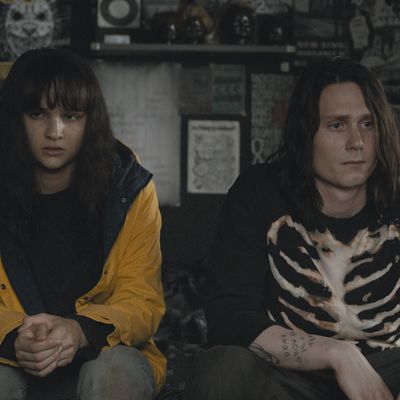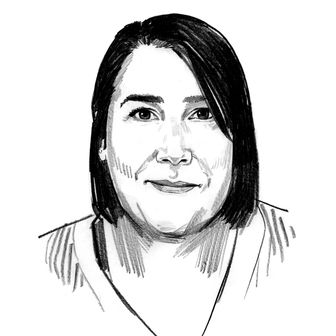
With a show as complicated as Netflix’s Dark, you’d think it’d be impossible to wrap up every story line — but Dark has a character who gives birth to her own mother, so doing the impossible is pretty much its thing. The second season of the German-language series left off with a character from another universe showing up to save time-traveling teenager Jonas Kahnwald, just moments before the apocalypse. With the third and final season premiering over the weekend, Dark had eight episodes to conclude its trippy sci-fi saga — that, yes, now included not just multiple timelines to track, but multiple universes — in a satisfying way. And holy hell, did series creators Baran bo Odar and Jantje Friese pull the whole thing off. Even through all the twisty revelations about who is related to whom, which parents kill their kids, which kids kill their parents, and more than one timeline existing within each universe, season three provided a conclusive ending that made sense. But also, just typing that sentence made my brain melt a little, so who knows? Let’s untangle what befalls our Winden residents in the Dark series finale.
A trip to an alternate universe
We spend a lot of time in Alternate Martha’s universe, where Winden looks very much like the rural German town we’ve come to know over previous seasons. It turns out that this alt-Winden is almost exactly like our Winden: Things may happen in different ways or at different times, but the same result occurs. For instance, Ulrich once again follows Helge through time, believing he is wrapped up in his son Mads’s disappearance, but this time Ulrich travels to 1986 and attacks Helge as an adult, not a young boy, and leaves his eye disfigured instead of his ear. Also, in this alternate universe, Ulrich has left Katharina to be with Hannah, but he’s still off having an affair — this time it’s with Charlotte Doppler.
The biggest difference in alt-Winden is a huge one: Mikkel never traveled back in time, therefore his son Jonas/Adam doesn’t exist in this universe. However, that doesn’t mean someone isn’t moving chess pieces around in the battle with time. Where our Winden has Adam, alt-Winden has a mysterious figure named Eve … who turns out to be alt-Martha! The two worlds are bound together in a knot that perpetuates the endless cycles we’ve seen play out. But while Adam wants to destroy the knot and end all of the suffering and tragedy, Eve wants to preserve the knot.
Why does Eve want to preserve the knot?
To answer that, we have to talk about the moment that Adam and Eve believe is the origin point of the knot, a.k.a. the specific event that kicked off the time loops. After alt-Martha saves Jonas from the apocalypse, she ends up having sex with him and getting pregnant. As a child from both universes, their son grows up to become the root of Winden’s extremely knotty family tree: As a young man, he hooks up with Agnes Nielsen, who then gives birth to Tronte in both worlds. (Tronte then grows up to become Ulrich’s father, which means that Jonas and alt-Martha’s child is also their ancestor. He is Jonas’s great-great-grandfather and Martha’s great-grandfather.) After lifetimes spent investigating the loops, Adam and Eve determine that their son, this bridge between two worlds, must be the origin point of the knot.
Adam wants to stop his son from ever being born, thus destroying the knot and ending the cycles of tragedy. Martha, however, wants to protect her son, which means she believes she must preserve the knot and the endless cycles at all cost. Adam and Eve are constantly trying to outmaneuver one another to get what they want. In one reality, Adam kills pregnant Martha. In another, their child is born and we see him creeping around as a child, an adult, and an old man doing Eve’s bidding, murdering and/or manipulating people to preserve the knot.
Wait a second! What about alternate timelines?
No kidding. Just in case Dark didn’t give us enough things to keep track of, the third season also reveals that there is a loophole within the knot: When the apocalypse occurs (which happens days apart in the two universes), time stands still for a fraction of a second. Within that moment, a person can create alternate, simultaneous timelines within a single universe. In what feels like a predetermined loop doomed to repeat itself for eternity, this is the small moment when you can change things.
Here’s the deal: Adam has no idea about this loophole, but Martha does, and she’s been using it to her advantage. She creates two timelines within her universe, one in which she sends her younger self to save Jonas from the apocalypse and bring him back to her universe (a.k.a. what we saw in the season-two finale), as well as a timeline in which she sends Bartosz to stop Martha from saving Jonas. In that second timeline, Jonas rides out the apocalypse in the bunker under his house and never learns about the alternate universe; this is why Adult Jonas is so surprised when he meets alt-Martha in the 1880s. Eve needs both versions of her younger self to carry out her mission to preserve the knot and keep her son alive.
But there is one other character who learns about the importance of alternate realities …
Give it up for Claudia Tiedemann, everybody!
Claudia wins the gold star for cracking time travel. Working alongside the alternative version of herself from the other universe, she assists Eve in her fight against Adam. At some point, an older version of herself tells Claudia that if everything they’re doing works, their daughter Regina will live. But later, Claudia learns that Regina dies in both worlds no matter what she does, which leads her to conclude that a third universe must exist.
Claudia eventually figures out that she’s right: The two universes of Adam and Eve were never supposed to exist in the first place, and there’s an origin universe where all of this started. In the origin universe, H.G. Tannhaus loses his son, daughter-in-law, and granddaughter in a car accident in the 1970s. He builds a machine to save his family and bring them back to life. When he uses this machine in 1986, though, he ends up simultaneously destroying his universe and creating the two universes we’ve been hanging out in. As Old Claudia eventually tells Adam, Tannhaus using this machine is the actual origin point of the knot: The only way to end all the pain and suffering of the time loops is to stop Tannhaus from ever wanting or needing to make his machine. His son must live, people! And the only people who can save him are Jonas and alt-Martha.
How Jonas and alt-Martha save the world
Moments before the apocalypse, Adam arrives in the universe where Jonas is grieving over a dead Martha and gives him the information he needs to stop the madness: If he and alt-Martha travel to the origin universe and save Tannhaus’s family, the knot will never exist. So, this version of Jonas travels to the timeline where Bartosz stops alt-Martha from saving Jonas, then turns on his time-machine orb and whisks her away before Magnus and Franziska recruit her to join Team Adam. Please keep in mind that these versions of Jonas and alt-Martha have never met, yet they feel intensely connected because fate and destiny and love.
Here’s the plan: Jonas and Martha must wait in the tunnels on the day that Tannhaus creates time travel in the origin universe. At that exact moment, they’re able to travel into the origin universe by way of a time bridge (it is very pretty but also wild!). Once there, they travel to the night of the car accident and stop Tannhaus’s son and daughter-in-law from driving off to their deaths. With his family alive, Tannhaus no longer has a reason to build his machine. And thus, the other universes are never created. The plan works! You know how they know it works? The two other universes and everyone involved in the knot start fading away. Jonas and Martha hold hands as they turn into light that flickers out of existence. Dang, this is emotional.
What happens in that final scene?
Dark’s final scene shows us what present-day Winden looks like in the origin universe. Most of the characters we’ve come to care about were tied up in that time knot — Jonas, Noah, Charlotte, Elisabeth, Franziska, all the Nielsens — and therefore don’t exist anymore, but the characters who existed outside of that knot are seemingly free from the tragedy they were doomed to repeat over and over. During a celebratory dinner at Regina’s house, we see that Regina had a much happier childhood with her mother, Claudia, and her father … Bernd Doppler! Hannah, who in this universe doesn’t travel to the early 1900s to be murdered by her own son, is happily pregnant with Wöller’s baby! (Wöller begins to tell the story of his eye injury — it’s healing up nicely in the origin universe, by the way — only for the tale to be interrupted by a blackout. Peter and Benni are finally together, and Katharina is at the dinner party, too. Honestly, if some version of Katharina didn’t get a happy ending, it would’ve been TOO MUCH.
After the power goes out at the dinner party, Hannah gets a glimpse of a yellow raincoat that triggers some major déjà vu. She gets very existential about a dream she had about darkness (like fading from existence, perhaps?), and even in this origin universe, our remaining characters can’t help but toast to a world without Winden. And then, when asked what she’s thinking of naming her baby, Hannah replies, “I always thought Jonas was a good name.”
This ending is obviously up for interpretation: Is this just part of another cycle? Is Winden doomed no matter what universe it exists in? Or is this simply a hopeful conclusion that suggests that no matter what, some version of Jonas will exist and maybe, just maybe, this Jonas will live a life free of time travel, tragedy, and needing copious amounts of string to keep track of his family tree?


